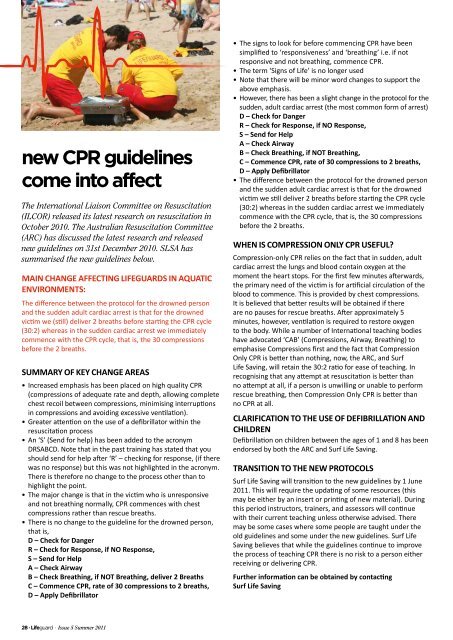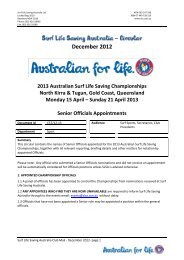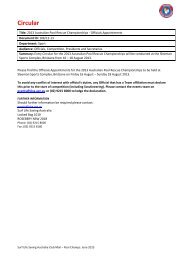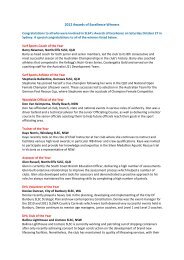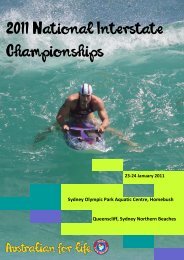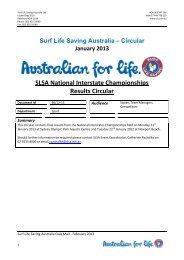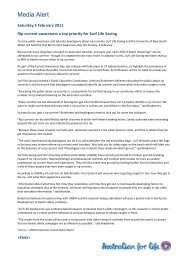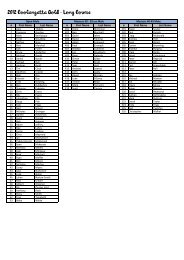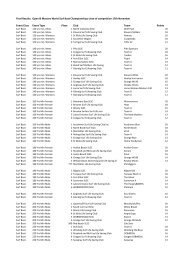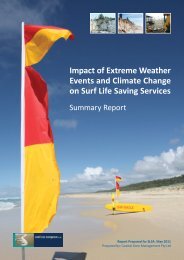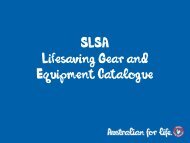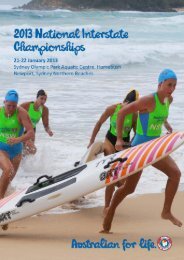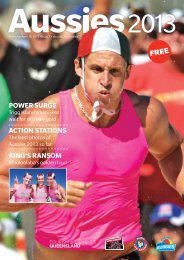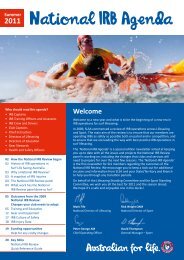Australian Lifeguard magazine - Surf Life Saving Australia
Australian Lifeguard magazine - Surf Life Saving Australia
Australian Lifeguard magazine - Surf Life Saving Australia
Create successful ePaper yourself
Turn your PDF publications into a flip-book with our unique Google optimized e-Paper software.
new CPR guidelinescome into affectThe International Liaison Committee on Resuscitation(ILCOR) released its latest research on resuscitation inOctober 2010. The <strong><strong>Australia</strong>n</strong> Resuscitation Committee(ARC) has discussed the latest research and releasednew guidelines on 31st December 2010. SLSA hassummarised the new guidelines below.Main change affecting lifeguards in aquaticenvironments:The difference between the protocol for the drowned personand the sudden adult cardiac arrest is that for the drownedvictim we (still) deliver 2 breaths before starting the CPR cycle(30:2) whereas in the sudden cardiac arrest we immediatelycommence with the CPR cycle, that is, the 30 compressionsbefore the 2 breaths.Summary of key change areas• Increased emphasis has been placed on high quality CPR(compressions of adequate rate and depth, allowing completechest recoil between compressions, minimising interruptionsin compressions and avoiding excessive ventilation).• Greater attention on the use of a defibrillator within theresuscitation process• An ‘S’ (Send for help) has been added to the acronymDRSABCD. Note that in the past training has stated that youshould send for help after ‘R’ – checking for response, (if therewas no response) but this was not highlighted in the acronym.There is therefore no change to the process other than tohighlight the point.• The major change is that in the victim who is unresponsiveand not breathing normally, CPR commences with chestcompressions rather than rescue breaths.• There is no change to the guideline for the drowned person,that is,D – Check for DangerR – Check for Response, if NO Response,S – Send for HelpA – Check AirwayB – Check Breathing, if Not Breathing, deliver 2 BreathsC – Commence CPR, rate of 30 compressions to 2 breaths,D – Apply Defibrillator• The signs to look for before commencing CPR have beensimplified to ‘responsiveness’ and ‘breathing’ i.e. if notresponsive and not breathing, commence CPR.• The term ‘Signs of <strong>Life</strong>’ is no longer used• Note that there will be minor word changes to support theabove emphasis.• However, there has been a slight change in the protocol for thesudden, adult cardiac arrest (the most common form of arrest)D – Check for DangerR – Check for Response, if NO Response,S – Send for HelpA – Check AirwayB – Check Breathing, if Not Breathing,C – Commence CPR, rate of 30 compressions to 2 breaths,d – Apply Defibrillator• The difference between the protocol for the drowned personand the sudden adult cardiac arrest is that for the drownedvictim we still deliver 2 breaths before starting the CPR cycle(30:2) whereas in the sudden cardiac arrest we immediatelycommence with the CPR cycle, that is, the 30 compressionsbefore the 2 breaths.When is Compression ONLY CPR useful?Compression-only CPR relies on the fact that in sudden, adultcardiac arrest the lungs and blood contain oxygen at themoment the heart stops. For the first few minutes afterwards,the primary need of the victim is for artificial circulation of theblood to commence. This is provided by chest compressions.It is believed that better results will be obtained if thereare no pauses for rescue breaths. After approximately 5minutes, however, ventilation is required to restore oxygento the body. While a number of International teaching bodieshave advocated ‘CAB’ (Compressions, Airway, Breathing) toemphasise Compressions first and the fact that CompressionOnly CPR is better than nothing, now, the ARC, and <strong>Surf</strong><strong>Life</strong> <strong>Saving</strong>, will retain the 30:2 ratio for ease of teaching. Inrecognising that any attempt at resuscitation is better thanno attempt at all, if a person is unwilling or unable to performrescue breathing, then Compression Only CPR is better thanno CPR at all.Clarification to the use of Defibrillation andChildrenDefibrillation on children between the ages of 1 and 8 has beenendorsed by both the ARC and <strong>Surf</strong> <strong>Life</strong> <strong>Saving</strong>.Transition to the new protocols<strong>Surf</strong> <strong>Life</strong> <strong>Saving</strong> will transition to the new guidelines by 1 June2011. This will require the updating of some resources (thismay be either by an insert or printing of new material). Duringthis period instructors, trainers, and assessors will continuewith their current teaching unless otherwise advised. Theremay be some cases where some people are taught under theold guidelines and some under the new guidelines. <strong>Surf</strong> <strong>Life</strong><strong>Saving</strong> believes that while the guidelines continue to improvethe process of teaching CPR there is no risk to a person eitherreceiving or delivering CPR.Further information can be obtained by contacting<strong>Surf</strong> <strong>Life</strong> <strong>Saving</strong>28 · <strong><strong>Life</strong>guard</strong> · Issue 5 Summer 2011


